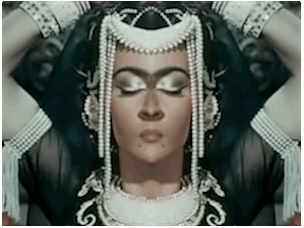
‘Walter Benjamin had it wrong when he spoke of the loss of “aura” in the age of mechanical reproduction. In his essay, film has all the radiance of a postcard. Perhaps he was always wrong? In that place, time, audience, projection speed and print damage meant each screening could have its unique flavor and memory. Seeing Hollywood features in the balcony of a Newark, New Jersey downtown theater, its floor crunchy with popcorn, sticky with candy and noisy with audiences who did not hesitate to speak back to the screen, is one such example. Experiencing Do The Right Thing in a spic & span New Jersey shopping mall with a largely white audience who walked out head bowed is another. Going to a drive-in movie as a pre-teen where the prints were so beat up and “reproduced,” the advertised pizza looked like nothing but a bloody bruise slipping off the screen – hysteric materiality – unforgettable.
‘Now, with the rise of digital reproduction, its endless and presuming exact cloning – it appears film has become rarer and rarer, and thus, full of aura. Film has no longer the pretense of an infinitely repeatable production but exists as a nearly extinct species. Its glories renewed, revived and praised when a preserved print is shown – shockingly precise and at full resolution – a silky shine clinging to its industrial past. Not so much nostalgic, though there is some of that operative – but rather, a physicality, a depth, a “look” that neither video, HD, nor digital can project. The rise of these new technologies successfully redefine film: celluloid as industry is defunct, hail celluloid as art!
‘Examples abound. The print itself becoming rarer and rarer as stocks go out of production – whether Kodachrome, acetate print stock altogether, or reversal ultimately. The print becomes unreproduceable. Films that were shot in or printed in Kodachrome can be so no longer. Thus, the five copies of my film Ornamentals (1977) are now a limited edition. Or Nathaniel Dorsky, an artist who has shot Kodachrome exclusively, is experimenting with other film stocks but cannot get the same contrast or reds that that original camera stock contained. As aspects of prints fade, much as a painting might crack or become dirty over time, the film begins to disappear. The 100-year history of film is chockablock with lost originals and/or prints and now, prints can’t always be recovered because of fading or breakage. Such an example, Mutiny (1982) used workprint to cut in with reversal original. Workprint was/is developed differently than original. It is not intended to last and indeed it has not. It has gone red – the magenta that celluloid aspires to (as with tulips, whose original color is red). This means there is difficulty in getting the footage to what it was; this means only one print remains without scratches, cuts or broken sprockets. Thus Mutiny is a mono-print, the only print. The implications are large: I hesitate to show it except at forums where the projection is controlled and I am in attendance. Suddenly a populist medium has become that of the specialist.
‘Perhaps in the more rarified atmosphere of the art film, the experimental film or independent film, this has always been the case. Many prints of Report (1967), which Bruce Conner distributed personally, were actually monoprints, in that he would tinker with individual prints extensively. I have seen at least four different versions in which the montage changes, sometimes in length, sometimes in the image itself. It was a privilege to buy one of these prints that had its cut-ups intact.
‘Then again prints get scratched. They are such “tender” vehicles of image and emotion (however deep their impact). The scratches disturb rhythms, undo meaning, destroy aesthetics. And there might very well be no existent negative. The film/digital divide makes me think of the divisions between oil painting and acrylic from the mid-twentieth century. I can only hope that just as oil painting survived with small producers, celluloid will as well. Am I being unjustifiably optimistic?
‘Ironically film is, in some ways, cheaper than digital: does not need computers that change every year, does not need ever-changing software or more memory. Instead its mechanical machines last for 20, even 30 years, and do just as well as they did in their original state. It was Arthur Jafa (aka “AJ,” marvelous cameraman for Daughters of the Dust and Crooklyn) who taught me how to make video look like film. I told my students video could do this. But I lied. Recently shooting film I realized how wrong I was. As of now, film remains, what AJ calls, the gold standard of image making—what “is considered definitive.” A nineteenth century relic then, or is film the definitive icon?
‘When one sees film, the image shudders, there is a little shake as the film moves through its sprockets – it reflects tenderness, fragility, mortality. Like rockets blasting into space, it has hubris and a mortal life. It recovers and uncovers a world. Like the touch of a lover, it has a remembered feel, smoothness and depth, a purity of complex light. It is silky without flatness. It won’t let go. Perhaps because we grew up with this form of representation, one can’t imagine a world without this satisfaction. How could the blank faces of corporate bottom lines allow this to happen? How could machines replace older machines with less authenticity? How is memory erased? Is the future not a projection in a community space, but rather individual peeks at Vimeo? How can the medium go extinct and yet continue its message?
‘Personally, I can’t let celluloid go. It’s too much fun. The little yellow packages, that like taxis, take you to and fro over the globe and inside communities, architecture, places and peoples. Film challenges you to lug that camera into the world, to observe exactly, succinctly. Not surveillance, but selection. Not anything goes, but everything possible. Not turn on switch and go, but turn on and attend. You find a corner in shadow to change the film and not expose the “daylight” rolls. You remove carefully the pieces that get “left” in the Bolex. You read a light meter and decide whether to shoot for the shadows or for the light. You refocus. These are skills, attitudes, a philosophy of seeing – that will be lost to automatic switches. But it need not be a battle, no need for automatons.
‘My memories include that of hand-developing reversal film: when the strip of film comes out of its first “bath” in chemicals, it is a negative image covered with a milky caul. A shock of light (a bulb in our set-up) undoes the caul, reverses the negative image and a positive appears: ethereal, shiny, gorgeous, miraculous.
‘Alternative to such alchemy – I remember getting a print back from a submission (yes we sent prints themselves!) with a deep scratch down the entire film. Or a print coming back with surrealistic timing, the lab having made a mistake. And of course no DVD to mail in when a curator requests same, no Vimeo for programmers to watch in their considerations. Yes. There is gain as well as loss. No doubt.
‘So – I say hello to digi-land but I reject it too or want to. We are all taken by our corporate sponsors: so clear and so debilitating. My art determined by digi-world where previously it was determined by Kodak? Perhaps yes, yet the digital cameras, the Canon for example, designed to resemble film, makes China look like Staten Island. Film becomes nostalgic, an effect in corporate software – that removes difference and flattens the affect of the person behind the camera.
‘Am I being nostalgic myself? Writing evolves – stick in dust, stone, ink, pencil, typewriter, computer – and yes there is that difference and it makes a difference. The means reorders my attachment1. All those years of cut and paste and now there is copy and paste. Digital editing serves as both optical printer and editor. The computer supplies you with a copy machine. NO resistance to multiplication. We are industry and industry is us. We are condensed, packaged, replicated (?) for the future. We mediate the medium. We are the mediating heart of the world we are analyzing and inventing. We are pushing the hearts of the world in and out again, pumping, pulsing, perturbed, perplexed, persistent.’ — Abigail Child
_____
Stills


















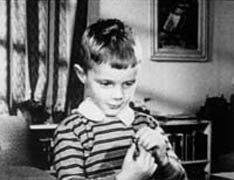


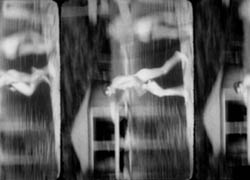


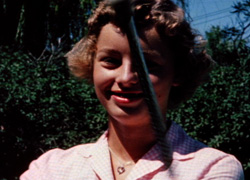
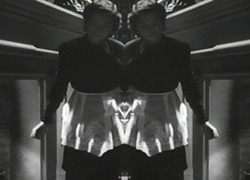

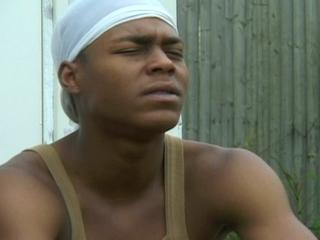
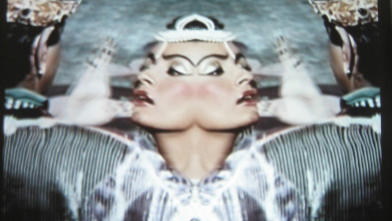



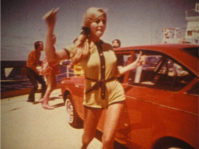


____
Further
Abigail Child Site
Abigail Child @ Wikipedia
Abigail Child @ Filmmakers Cooperative
Abigail Child @ Video Data Bank
Abigail Child: Films and a Lecture
Crushing Mimesis
How many, how many, how many? “Mayhem”
Acts and Intermissions
In the Flat Field: Two Films by Abigail Child
An Experiment in Autobiography
Abigail Child @ PennSound
Abigail Child @ MUBI
Book: ‘Mouth to Mouth’
From ‘No To Both Ideas’
This Is Called Moving: A Critical Poetics of Film by Abigail Child
This Is Called Moving: A Critical Poetics of Film by Abigail Child
Sounds, Intervals, and Startling Images in the Films of Abigail Child
Is this what you were born for?: Abigail Child and the poetics of the swoon Is this what you were born for?: Abigail Child and the poetics of the swoon.
Artificial Memory
PERILS, MUTINY AND MAYHEM
Abigail Child & Peter Bo Rappmund
Private Eye: Avant Garde Filmmaker Abigail Child in Brief
_____
Extras
Canyon Cinema 50 – Interview with Abigail Child
This is “Abigail Child”
______
Interview
from hambre/espacio cine experimental
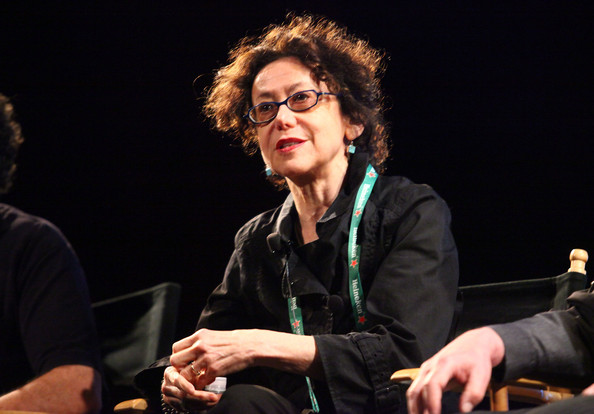
No doubt good humor is something very important in your life. How do you feel that this fact influence your work?
The world is entertaining and comical in its absurdity and its beauty. Humor is the other side of great tragedy: what is left when the abysmal happens. Humor is also or therefore Courage. Humor is very human.
All doubt.
There’s something very ludic/playful in your images, as if you were not afraid to play with them, as if you want to always open the images and give them multiple senses. A performativity of the image. It is never what it seems, is not a window to the world. It is a vehicle, a medium where the reality we see is just the starting point. How do you feel this in your work, I mean, this condition of the image?
Yes and yes. “Not afraid to play… to always open the images and give them multiple senses”. They have these. I thought of this as action, an enacting that the audience protracts and redacts through their body and mind. The world is not what it seems certainly or the seams are what we don’t see and I want you to look at that. The starting point is the vehicle, the body is the vehicle; the medium is the world. It is always moving. You are moving inside it——a voyage but hopefully not a travelogue. More a big swim. Immersed.
Felt an instant rapport with Phenomenology when first read it.
In Goiania I could see your four recent works. All of them very different from each other. Elsa, Vis à Vis, Unbound and Riding the Tiger. And certainly I could see that you have different ways of understanding the montage and structure possibilities. Could you talk about your conceptions and ideas about it?
I see more relations between the films. Unbound is a version of The Future is Behind You from almost a decade earlier in their mutual ideas of home movies as fiction. Elsa merdelamerdelamer is a kiss, an angry and fearful one, while Vis å Vis is a series of loving kisses. The first one is a homage to the past and the other to my contemporaries.
Riding the Tiger is more anomalous perhaps though I started as a documentarian. Game, (1972) a portrait of a prostitute and her pimp on the streets of New York prefaces Mayhem (1987) as well as B/Side (1996); also, On The Downlow (2007) negotiates sex on the margins as do both my earlier and later works: Mayhem again, also Covert Action (1984), Perils (1986) and Ligatures (2009).
There are city symphonies that thread through: Below the New (1999) in Russia and Riding The Tiger (08-2014) shot in China. Here my sense of sudden change and cultural incomprehensibilities and resulting tragedies that include denying/erasing history —come to the fore.
Sound also plays a key role in how you compose your films. In fact when I said that I feel that there is something ludic/playful in your images, I think it is also due to the relationship that is woven between what we see and hear, a complex relationship. As if the sound does not let the image be anchored. Instead the sound makes the image freer. Tell me about your relationship with music / sound and how you feel that it operates in your films.
Sound is where my work comes together formally or rather my interest in changing the image is enacted. Playful and “unanchored”. That last a good word. The sound makes the image more free. I learned a lot about music in recording studios in the ‘70s. In one case, a newly composed song was played by Stevie Winwood and Traffic one day and the next, by a group of black studio musicians. The recorded music was completely different in these two sessions: bodies were different, tone, histories, rhythms— the way the music lifted from these mixed particulars.
Rhythm is important to my work, to all art. If it doesn’t move, it can’t live. Rhythm can make a work flat or humorous or fabulous. Rhythm is the movement of all of us on a planet that keeps moving, as so are we always in movement.
In Unbound is more specific, you have a strong relationship with memory. Still, it is something present in all the works you presented. How do you feel and see the relationship between memory and your images? How does memory influence your ideas of montage?
After watching a number of my films, a colleague commented that my works were all about rewriting history. He was right: to make a history I can live with, critique a history that deserves it, go below the surface and discover the situation inside the global moment: whether it is young girls growing up between the war (The Future Is Behind You) or a teenage writer negotiating children and writing with a romantic husband (Unbound).
I am always surprised by people who don’t like or know history. History is not merely what has happened, but the cultural ground of the Now. The future is behind you…
The feminine is also something recurrent in your work; proof of this is your trilogy in progress started by the figure of Mary Shelley. Tell me a little more about this project in three movements.
I am concerned not with the feminine so much as the life of women. This is underdeveloped in the world: in politics, in history, in literature. It’s so easy to forget women got the vote only in the last 100 years and more recently across the globe. We are new in the world and to ourselves in this power to speak. We need to strengthen all possibilities and our prior absence offers an open field of study and exploration.
Much of my work deals with the female body. In Is This What You Were Born For? my series of 7 films from the 80s, Mercy —the last film in the series— uses the male body as a structuring device. On The Downlow also negotiates male desire, but in the main, women and women’s bodies are a focus in my films: whether that be the princess and peasant who exchange roles in MIRROR WORLD or teenagers in CAKE AND STEAK or women of an orthodox family in SURF AND TURF, or the mythological evil wife in DARK DARK. Women are interesting, complicated and being one, the issues are available to be explored are multiple. Whether in terms of bonding, jobs, biology, feelings, history, destiny —women are the underdeveloped sex, as story and fact, in public and interiorly, complicated and crisscrossed by exterior demands and unfreedoms.
When editing UNBOUND I realized the film was about the failure of ideology for women and I had this idea to continue beyond Mary Shelley and Romantic of the 19th century (filmed in Italy), to explore Emma Goldman and Anarchy in the 20th century (filmed in NY City) and Woman and Science in the 21st century in Tokyo. That these issues played out as ideological hierarchies and that for women these absolutes did not always allow them permission for love and creativity. Mary Shelley is constrained by the societal mores of her time. She was rejected by contemporaries and even after Shelley’s death, treated as a pariah. She remained faithful to Shelley and Romanticism but this faith seems a dependency rather than a freedom later in her life. Emma Goldman believed in free love and anarchism but ultimately renounced violence and suffered in her love life. She asks plaintively what people would think to realize the notorious activist was sobbing for her lover? It was hard to reconcile her life with her loves and often the lovers wanted her to quit her public roles—a repeating conflict between interior and exterior demands. The heroine for our current century would be virtual and the setting… a Tokyo of the future. The last is still percolating as I work on the current film.
You also write poetry and you have told me that often you carry several projects in parallel. How do you feel this influences your creative process? Anyway, tell me about how you think your creative process works. What influences you? What allows you to flow more in your process?
I do projects in parallel mostly because the ideas are churning and there is never enough time. Many of my films are short, as are individual poems or even critical articles—the latter show up collected into books and occasionally the short films form a feature-length trilogy. This trilogy is an attempt to do longer works, but shorter works keep cropping up as opportunities (Elsa merdelamerdelamer and Salomé) or standing excitements from my personal archive. Vis À Vis is typical of the latter in that I saved the footage over time whenever I was logging my material. I had a first idea for this film a decade ago. It took until 2013 for the idea to come to fruition.
Ideas are multiplying and leftover and finally attended. My job teaching in Boston is more interruptive than if I were living in the same city (I live in NYC). Once I am not working, my process might change. On the other hand, I have always had a multiplying mind: writing and film, a member of both my cooperative apartment and my city garden. I find working with others and perhaps multiple projects allows me a certain kind of freedom, allowing things to happen that wouldn’t otherwise. So that the cross fertilization of people, ideas, art forms, and projects is essential to my process.
At some point we talked about what would be a political film and both agreed that a film can only be political when it proposes new forms. That is, when form is the real content. Could you tell me more about it on the relationship between experimental film and politics?
To be clear I don’t think art changes the political facts. Perhaps Errol Morris’s film The Thin Blue Line is the exception to prove the rule. Art rather prepares the ground for change. It opens the mind, changes the structure and allows for new ideas and new structures. Shelley’s comment that “poets are the unacknowledged legislators of the world” is not, perhaps never was, true but we are poet thinkers and politics are in our world.
I add that the artists who say their work has no politics have a politic: they are approving the status quo as well as tuning out the world, saying art exists outside that world. Rather art is part of the socios, part of culture, and needs to be, to be relevant. Not to say the personal or the interior life isn’t important, just that it exists in relation. We are not sui generis. We are born into a world that re-configures us, and it is naïve to think we are not. We are not unitary nor singular nor alone. We are part of relations, albeit fractured, ambient, elastic, close.
You’ve written a book on film theory and you told me that you have another one in preparation. You teach also in SMFA Boston. Tell me a little more about your critical and pedagogical work. Do you feel that is something that nourishes your artwork? In what way?
Cage suggests that inspiration and analysis should be separate. I agree. Once you have had that inspiration and made a work, or begun one, the analysis comes in. It is helpful to examine what you have done: does it transform? Meets your expectations? Does it give you a clue where to go next?
Poets I know in the 70s said theory is poetry or can be, and they pointed to Walter Benjamin. Surely not all theory reads as poetry but a poetics might. How something is done is as important, more important often, than why. Artists writing about their work are liberating, particular and informative. [Why we love interviews so much]. I value my reading of Valery, Benjamin and Artaud, Barthes, Virillio, and diaries and texts by artists such as Bacon, Vertov, Eisenstein, Stella, Klee, Kubelka, Viktor Shklovsky, Zukofsky, Stein (the list can go on and on and on). These are lively thinkers and often dynamic writers. I may not think of them when I am creating but their ideas can give me strength to continue. The same for my own critical writing and pedagogy. They challenge my thinking and my art.
Finally, what would you say, what advice/message you’d let to the new filmmakers or to the incoming ones?
A film or a cinematics of image —is numerous, exciting and powerful in our culture. Knowing how to look behind and around and aside the image is more important than ever. The art is young, there’s much to explore. Bring a criticality to your investigations and simultaneously be light with it.
_______________
11 of Abigail Child’s 46 films
_______________
Mayhem (1987)
‘Through a catalogue of looks, movements, and gestures, Mayhem presents a social order run amok in a libidinous retracing of film noir conventions. Sexuality flows in an atmosphere of sexual tension, danger, violence, and glamour; antagonism between the sexes is symbolized in the costuming of women in polka dots and men in stripes. Censored in Tokyo for its use of Japanese lesbian erotica, this tape creates an image bank of what signifies the sexual and the seductive in the history of imagemaking, pointing to the way we learn about our bodies, and how to use them from images.’ — Video Data Base
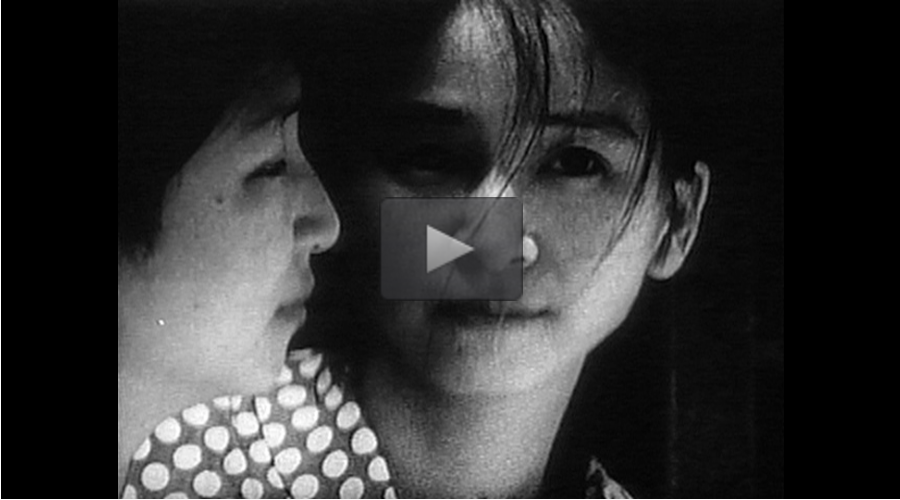
____________
Both (1988)
‘A beautifully ambiguous study of the nude in light and movement, this short silent film focuses on the dimly lit bodies of two women shot from Child’s distinctly non-male perspective.’ — Video Data Base
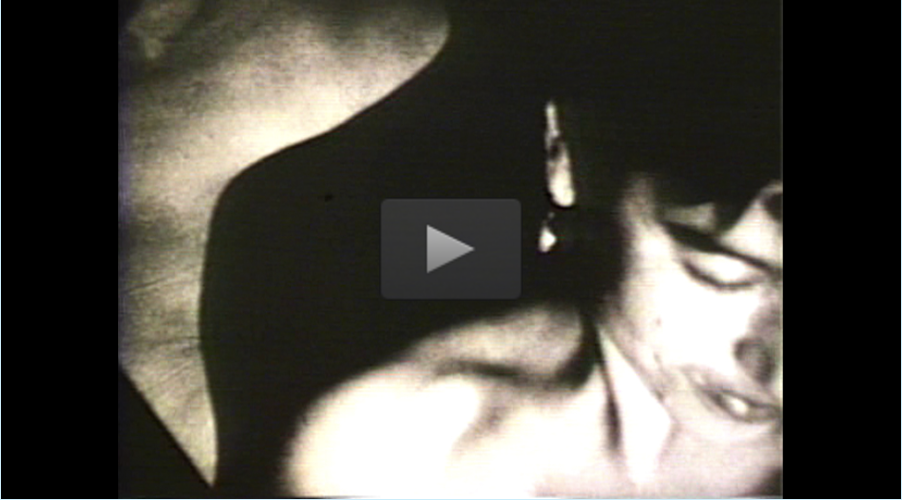
_____________
Mercy (1989)
‘Child masterfully composes a rhythmic collage of symmetries and asymmetries in a fluid essay that forefronts the treatment of the body as a mechanized instrument — placing the body in relation to the man-made landscape of factories, amusement…’ — Video Data Bank

_______________
w/ Sarah Schulman Swamp (1991)
‘Child uses the soap opera format to play with the structure and expectations of the family melodrama. Following the melodramatic format that “if it can happen, it will happen,” coincidence and unlikely events abound in Swamp’s gleeful send-up of lurid intrigue, threatened morality, and endless double-crosses. With looped and repeated edits, fast-paced action, and aggressively funky video effects, Child layers on artifice and excess in an overdone remake of the TV serial.’ — Video Data Bank
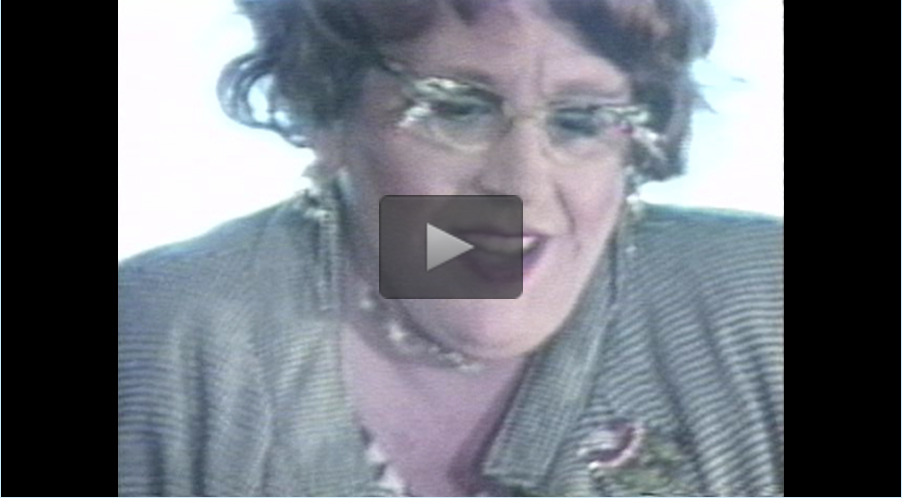
________________
Cake and Steak (2004)
‘Cake and Steak excavates ‘girl training’ in the legacy of home movies and post-war American suburban culture. Constructed as a series of a-chronological ‘chapters’ in which Edenic images of adolescent twirlers, basement parties, and ‘dress-up’ are challenged by a sound montage composed of horror movie music, old TV shows, laugh tracks, and machine noise of our modern Arcadias, Cake and Steak is conceived for single-screen, loop and multiple projection.’ — ChildWorks
Trailer
______________
On The Downlow (2007)
‘In this artful and thought-provoking film, highly regarded experimental filmmaker Abigail Child follows four young African American men in urban Cleveland, Ohio, who all live life on the downlow (the DL). Uncomfortable with being termed gay, as it doesn t correspond with their concept of Black masculinity, the men in this film straddle two seemingly incompatible worlds. Billy claims that the best sex of his life was with the mother of his two children, but he lives with a man. A self-described thug, Ray prefers drag queens. Kerwin desires not only a beautiful woman on his arm, but a man as well. And Antonio, an ex-con who picked up the DL lifestyle while incarcerated, is dating George, whose teenage girlfriend doesn t know that George, too, is on the DL. Together, these men s stories offer a rare window into both the allure and struggle of the DL lifestyle. Interweaving their narratives through candid interviews and intimate cinematography by Arthur Jafa (Crooklyn, Daughters of the Dust), ON THE DOWNLOW offers a penetrating glimpse into a split existence: one life lies on the surface, and another is hidden below.’ — collaged
the entire film
______________
(If I Can Sing a Song About) Ligatures (2009)
‘Exploring the relationship between text and image, (If I Can Sing a Song About) Ligatures focuses on how text turns into an image, spins it in its spot acknowledging the alphabet is history with power to lever. Words taken from lines of Gordon’s unrequited love poems, whose sentences are taken in their turn from anonymous web poems, become a history of sexuality. Ligatures pronounces the poignancy of desire: its power and simultaneously its vulnerability. The women are visions, girls, desirous, delicate, illusory. The illusory nature is manifested — crossing the boundaries, expectations and physical limits. We in the audience remain transfixed.’ — impakt.nl
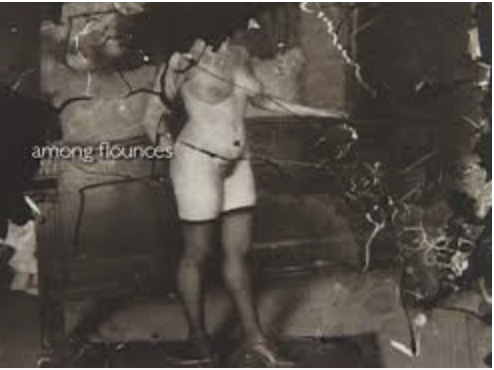
______________
The Suburban Trilogy (2011)
‘A feature length project about girlhood and the immigrant dream, focusing on post WWII North American suburbs and between the war Europe, critically seem through the lens of gender, property and myths of nation. – A rambunctious embrace, body to body, woman to woman, entrance to exist – in-laws foregrounding the construction of cinematic meaning, the elusive nature of memory and desire, the hysteric familial area of the social. The project is prismatic, in that each part explores a different perspective in terms of both cinematics and historical era.’ — Filmmakers Coop
Trailer
______________
A Shape Of Error (2011)
‘An experimental l6mm feature, A Shape of Error is based on the life of Percy Bysshe Shelley and his second wife, Mary Wollstonecraft Shelley— writers whose lives forecast the modern in their concern for women, free love and labor. Child retells their story as an imaginary home movie, using strategies developed in her earlier films—The Future Is Behind You (2004-05) and Covert Action (1984)— to shape a new kind of narrative. With sound by the acclaimed composer Zeena Parkins (who has worked with John Zorn and Bjork), non-actors in the lead roles and silently shot with Child’s l6mm camera, A Shape of Error is an original—startlingly emotional and engrossing.’ — ChildWorks
Trailer
_____________
Unbound: Scenes from the Life of Mary Shelley (2013)
‘In Rome for a year at the American Academy, I created imaginary home movies of scenes from the life of Mary and Percy Shelley. I was attracted to these authors — their life of poetry, politics and sexual invention—and inspired by my previous fictionalizing of home movies in Covert Action and The Future is Behind You. I worked with non-actors, the seasons and the extraordinary architecture and landscapes of Italy where the Shelleys were in exile for six of their eight years together. The result was a feature film A Shape of Error, gorgeous, emotional and harnessed to the narrative. I wanted to go further and abetted by digital technology, I have ‘exploded’ the film. The result is UNBOUND, digressive, looped, unpredictable, symphonic, spontaneous, messy—like life and memory. Music by Zeena Parkins.’ — Abigail Child
Trailer
_______________
Acts and Intermissions: Emma Goldman in America (2017)
‘A trailer for a new experimental documentary feature by Abigail Child. Never so relevant as now: a history of protest for fair wages, free speech and birth control. In the early 20th century, Emma Goldman was viewed as the Most Dangerous Woman Alive and her legacy continues. She believed in the anarchistic ideal of individualism and ultimately, non-violence, yet she also felt beauty, art, fun itself, were part of the freedoms for which she was fighting. This conflict between revolutionary purity and personal freedom underlines the continuing conflict between law and justice, and foregrounds Goldman’s strong feminist stance. Blending archive, contemporary observational views, re-enactment and text, the overlapping of present and past events expand narrative dimensions. ACTS & INTERMISSIONS looks at core issues of our times, inequalities most starkly in play in the past but that don’t go away in the present. Whereas the despots of the 20th century wore uniforms, the despots of the 21st wear suits. Spread the word!’ — ChildWorks
Trailer
*
p.s. I don’t really have words yet to find much less express my devastation at the death of my dear friend and literary comrade and genius writer Kevin Killian on Saturday. I’m still in shock and wracked with disbelief. I have to leave it there. ** David Ehrenstein, I’ll go read that pomo essay, thank you. Everyone, Mr. Ehrenstein continues to have all sorts of goodies (DVDs, CDS, Records, books) available on the cheap to you lucky Los Angelenos. Hit him up to find out what your potential windfall could be @ cllrdr@ehrensteinland.com. ** Bill, Ha. Good questions. Curious what you’ll think of the Pat O’Neil works. I’m happy to see them getting out there. I’ll keep my eyes out for the Barbara Rubin doc. Huh. Hope you’re doing okay there in SF. ** TheKeaton, Hey. I love one man band artist guys. Missing link in what sense? Revved. Stuff’s good here other than my friend’s death’s effect. Working on the TV show, the new film, trying to find a slot to reenter my long, long dormant novel. Much love to you too. ** Steve Erickson, A pulled gun is so charismatic in the most terrible way. Yes, the forehead tattoo seemed like an awfully harsh punishment and a ‘cutting off your nose to spite … ‘ thing. Probably not true. ** liquoredgoat, Hi, Douglas. Oh, I like Melisa Broder’s poetry too. Nice feed. ** Shane Christmass, Ah, well, better than nothing. And I must know someone who can hook me up with Kanopy for a couple of hours. Thanks, man. ** Scunnard, Hi, J. Sweet. I’m liking the doc pix you’re posting on FB. ** Dominik, Hi, D! It’s so good to see you! I’m doing okay, but my friend’s death is being hard to process and deal with. But I’m good. Just the usual working on my projects and things like that. Mm, I’m one of the extreme oddballs who never really got into The Smiths or Morrissey. They/he just never excited me. I did play the hell out of one of his albums (‘Bona Drag’) at one point though. So I probably won’t read that book, although maybe that would be the way into him. Hm. Wow, that’s fantastic and exciting about you and your friends performing at a Chicks On Speed gig. That’s really, really cool. When will you and your friend start figuring out what you’re going to do? I think that’s a fantastic thing for you to do, obviously, and I’m very happy you said yes. I’ll be curious to hear how that develops and what happens. Awesome! Take care, pal, and I hope to see you again soon! Lots of love in return! ** James, Hi, man. Yeah, Kevin’s death is beyond terrible. I’m at a loss. Good god about your brother’s wife. My god. I’m so sorry. I hope for a miracle for her. I did receive ‘Haunted Girlfriend’, yes, very happily, and I’ve started reading it, and of course it’s absolutely stellar! Good luck with everything on your end, my friend. ** h, Thank you. Yes, it’s inconceivable and very hard. Take care. ** Thomas Moronic, Hi, T. Yeah, everything you said about Kevin. I just … yeah, I can’t find the words. On an extremely different note, I’m very happy to be in that ‘I, Transgress’ anthology with you. Love, me. ** Misanthrope, Hi, G. Yeah, huge, huge loss. I’ve known Kevin for forever, and he was never less than more gigantic than life. Thank you, man. Take care of yourself. ** Right. As you already see, I’m giving the blog over to the very interesting filmmaker Abigail Child today. I ask you to explore her work. Thank you. See you tomorrow.




 Now available in North America
Now available in North America 
Oh man, that one hurts. I’m sorry about Kevin. Love to you and love to Dodie. It’s a great loss and an affirmation he was here.
re: Punk Rawk… I feel like I’m missing something, maybe that’s part of the trick. Like there’s 5 great bands I don’t know that are essential. The same 3 chords and all that music, it’s magic. Wishing you a super bright day
Regarding Kevin Here’s the Stevie Smith poem read at the funeral in “Those Who Love Me Can Take the Train”
Abigail Child is mistaken about film and its affect on politics Eisenstein’s “Battleship Potemkin” for several generations BECAME The Russian Revolution. It’s since been replaced by Warren Beatty’s “Reds” See also Peter Watkins’ “La Commune de Paris, 1871” (2000) It’s the greatest political film ever made. Errol Morris annoys me more than I can say, His specious posturing is not a political position of any value.
Hey Dennis, my condolences to you in regards to Kevin. I’m stunned as well, and though I only ever met him the one time in real life (though I was online friends with him since… 2007 or so?), it’s a day the memories of which I still treasure. In any event I’m keeping in my thoughts those who knew him even better, such as you, Dodie, and so forth.
Hey Dennis, this has been a sad, sad weekend. It seemed just days ago that Kevin was his usual exuberant self, sharing exciting upcoming projects over cream puffs and tea. We’ll really miss him here.
Pat O’Neil’s Decay of Fiction was lovely and mesmerizing. Will definitely try to catch his installation at SFMOMA.
Bill
Really great article on Jean-Pierre Melville
Brilliant Abigail Child primer today – loads of stuff that’s new to me, and excitingly so for that matter. Thanks for always shining your light in the most interesting of places, Dennis.
Yes! Very cool indeed to appear in that new anthology alongside your good self and some other cool characters. I adore that piece of yours that’s included in there. Where/when is from, if you don’t mind me asking?
Love from here to you,
Thomas xoxo
Lacan le pere severe : A Parental Horror Story, every bit of which is real.
I’m sorry for your loss. While searching around to learn more about Kevin Killian I found a piece called “My Mixed Marriage” by Dodie Bellamy published in the Village Voice in 2000. It’s an extremely brave piece of writing and very timely for me after a weird Pride weekend of coming out to myself as a cis male lesbian.
I enjoyed Child’s writing about celluloid and look forward to watching her work (unfortunately most likely not on celluloid). A few days ago you asked me about cinema venues in Tel Aviv. There’s a Cinematheque and lots of smaller venues, but there doesn’t seem to be much emphasis on celluloid. I find this kind of liberating: in a city with lots of celluloid screenings I end up going to so many that there’s little time or money left for anything else. There could even be an opening to find a projector and start something.
My film school application is just about complete. Tomorrow I’ll just put some finishing touches on the written materials. The 5-minute sample video was a joy to make and I learned a lot from it. I’ll put it on YouTube as-is but I hope to keep gathering material and fixing technical hiccups.
What if you just pulled your long, long dormant novel out of the drawer and published it immediately as “My Long, Long Dormant Novel”?
I had heard about Killian’s recent hospital visit, but I didn’t learn about his ongoing battle with cancer till he passed. One of the uncanny aspects of social media is that I learned about his death on Facebook and also saw a post from his name – or posted by Dodie under it – dated 15 hours ago yesterday morning. It’s an enormous loss.
I’ve seen some of Child’s early films, like MERCY and B-SIDE, but I haven’t followed her body of work into the present.
On the other side of cinema, ROCKETMAN sure is lame. If you’re gonna make an Elton John biopic, doing it as a campy musical is probably the best way, but Dexter Fletcher has little feel for that aesthetic. It winds up as a sappy, self-serving ode to 12-step groups.
Just now I’m trying to get back into writing during this big gap between print sessions for The Call zine. There’s a deadline for the new Edinburgh-based literary horror zine Blood Bath who say they welcome experimental fiction. I’m working on something called Lena’s Haunted Tamagotchi which may well not be what they’re after but still, for the moment I think it’s a worthwhile exercise. Besides the deadline’s not til 1st August so I might submit something else entirely.
I heard Kevin was in a bad way just before I started some travels I’m now on, but it’s still shock even more than sadness I feel. He’s always going to seem like one of those larger than life, why didn’t we know what we had when we had him, kind of people.
I’m in Berlin now. I only found out yesterday that Eileen Myles and Ed White were doing a talk here tonight, and I thought seeing Eileen would feel like a connection to Kevin. But I got the venue wrong and showed up early but thirty minutes away. So . . .
I committed to some conference presentations so a couple of weeks ago I was in Oregon a dream thing at the Oregon Shakespeare Festival, and I was glad I was in a hippie Oregon town for a week. Couple days home and Arthur and I came for holidays to Berlin for ten days. Then I go on my own to my conf in Kerkrade NL, then a little downtime touristing on my own . . . first days without proximate deadlines in quite a while . . . never been to Maastricht before . . . hot springs soak in Aachen . . . friends reunion in Amsterdam . . I get to Paris on July 3. So I will pester you right away.
I remember a July 4 party at Bob Flanagan’s when Donald said he didn’t know what to expect, and I said, oh Bob’s just a sweet angel guy, and 5 minutes after we got there, I turned my head and there was Bob showing his genital piercings to a couple of wide eyed college age girls. If you know of any July 4th parties like that, please reserve me a place. Meanwhile I hope to see you very soon and bask in your Dennis Cooper aura. xo
Dennis, Thanks for the intro to Abigail Child. Totally new to me!
Man, how many times have you and I (and others, I’m sure) said on here how much we hate death and how much it sucks.
That’s one of the sucky things about Life and about getting older.
Sunday, a really nice girl I went to high school with also died. I wasn’t close to her, but a lot of my friends knew her well. Some had just gone and hung out with her a couple days before and were saying how great she was, cracking them all up. One of those people who you can’t find anybody who’ll say a bad word about her. And then BAM! She wasn’t sick or anything.
Take care of yourself, bud. <3
That photo of the Dallas shooter, dressed in armor, holding a rifle and an anime girl pillow: what the fuck is happening to America?
hi Dennis, sorry to hear about your friend Kevin. I didn’t know him well, but we had one FB conversation in messages, which I remember was quite lovely. A difficult day all around and glad it’s over. See you in the morning of a new day…K
Fascinating post! I love that first image. It is strange the whole digitisation of retro images.
Dennis!! I also wanted to pass on my love and let you know I’m thinking about you and this place and others who’ve ever called it a home away from home. It was a weird day, Sunday. Father’s Day and my dad’s birthday (he would’ve been 80), and I woke up to a message that my auntie had died. Then when I went online I found out about Kevin. I saw he’d been sick before but thought he’d got through it. Like so many have said, he was such a singularly brilliant writer and thinker and also so incredibly kind and encouraging to everyone. An enormous loss. And I can only imagine how you’re feeling. Extra Love from me to you and everyone he was closest to and everyone he inspired along the way. xx
Dennis,
I’ve been thinking of you since I heard about Kevin on Saturday. I’m so sorry. Kevin and Dodie were always so wonderful and kind to me. They always came to my shows and hand smart and funny thoughts about my work. I tried to see them whenever they were in LA. He was a part of so many people’s lives that the whole community is reeling. If I was in Paris I’d give you a hug. Love, B.